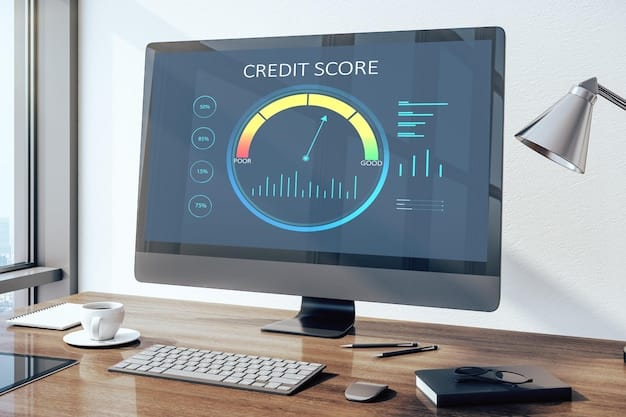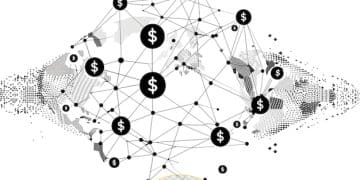How US Fintechs Use Machine Learning to Enhance Credit Scoring

US fintech companies are increasingly leveraging machine learning to revolutionize credit scoring models. This approach enhances accuracy, reduces bias, and expands financial inclusion, ultimately providing more equitable access to credit.
The financial technology (fintech) sector in the United States is undergoing a seismic shift, and at the heart of it lies a transformative technology: machine learning (ML). One of the most significant applications of ML within US fintech is the improvement of credit scoring models. But how are US fintech companies using machine learning to improve credit scoring models?
Traditional credit scoring methods often rely on limited data sets and can be biased, leaving many individuals and small businesses underserved. Machine learning offers a more nuanced and comprehensive approach, promising fairer and more accurate assessments of creditworthiness. Let’s explore how these innovative companies are harnessing the power of ML to reshape the landscape of credit scoring.
Understanding Traditional Credit Scoring Limitations
Traditional credit scoring models, predominantly used for decades, have several inherent limitations that US fintech companies are actively trying to overcome with machine learning. These limitations often result in inaccurate assessments and exclusion of potentially creditworthy individuals.
One major drawback is their dependence on a narrow range of historical data. Here’s a closer look:
Data Dependency and Bias
Traditional models heavily rely on credit history, such as payment records and outstanding debts. This creates a challenge for individuals with limited or no credit history, often younger people or those new to the country. Moreover, these models can inadvertently perpetuate biases present in historical data, leading to unfair outcomes for certain demographic groups.
- Limited Data Points: Relying mainly on past credit behavior overlooks other relevant financial indicators.
- Inherent Biases: Historical data may reflect societal biases, leading to skewed scoring.
- Exclusion of Thin-File Individuals: People with little to no credit history are disadvantaged.
These constraints highlight the need for a more dynamic and inclusive approach to credit assessment, which machine learning is poised to deliver. The reliance on static, historical data is a critical issue that machine learning helps address by incorporating a wider array of real-time and alternative data sources.

By moving beyond these confines, US fintech companies are using machine learning to improve credit scoring models, leading to more accurate and equitable lending decisions. This advancement is critical for fostering financial inclusion and ensuring that more individuals have access to credit opportunities.
How are US Fintech Companies Using Machine Learning to Improve Credit Scoring Models?
US fintech companies are revolutionizing credit scoring through machine learning by leveraging advanced algorithms and expansive datasets. This approach enables more accurate, unbiased, and inclusive credit assessments compared to traditional methods.
Here’s a more in-depth view of the specific techniques and data sources being utilized:
Advanced Algorithms and Techniques
Fintech firms employ a variety of sophisticated machine learning algorithms to analyze financial data. These algorithms can identify complex patterns and correlations that traditional models often miss, leading to more precise risk assessments.
- Neural Networks: Model complex relationships between financial variables.
- Decision Trees: Create segmented decision-making processes based on data patterns.
- Random Forests: Combine multiple decision trees to enhance prediction accuracy.
These advanced techniques empower fintech companies to make more informed decisions, reduce risk, and offer credit opportunities to a broader range of applicants. The capability to process and analyze extensive datasets in real-time distinguishes machine learning from its predecessors, allowing for continuous updates and improvements to the credit scoring process.
The integration of these technologies represents a significant leap forward, enabling fintech companies to assess creditworthiness with greater accuracy and fairness. Essentially, how are US fintech companies using machine learning to improve credit scoring models boils down to enhanced analytical capabilities and a more holistic view of an individual’s financial profile.
The Role of Alternative Data in Machine Learning Credit Models
Alternative data is playing a pivotal role in transforming credit scoring by offering insights beyond traditional credit reports. US fintech companies are using machine learning to improve credit scoring models by incorporating a wide array of unconventional data sources to assess creditworthiness.
Here’s a look at the vital role of alternative data:

Unconventional Data Sources
Unlike traditional credit scores that primarily rely on credit history, alternative data encompasses a broader spectrum of information. This includes utility bill payments, rental history, bank transaction data, and even social media activity. By analyzing these diverse data points, machine learning models can gain a more comprehensive understanding of an individual’s financial behavior.
- Utility Payments: Demonstrates consistent payment habits, reflecting financial responsibility.
- Rental History: Indicates the reliability of meeting monthly obligations.
- Bank Transactions: Offers insights into spending habits and cash flow.
Alternative data is particularly beneficial for people with limited or no credit history, enabling them to establish creditworthiness through non-traditional means. This inclusivity helps reduce disparities and ensures fairer access to financial services.
This expansion of data sources is not just about quantity; it’s about quality and relevance. Machine learning algorithms can sift through vast amounts of data to identify patterns and signals that are indicative of creditworthiness, thus refining the credit scoring process significantly. Therefore, understanding how are US fintech companies using machine learning to improve credit scoring models also means recognizing the importance of alternative data in broadening the scope of credit assessments.
Addressing Bias and Ensuring Fairness in ML Credit Scoring
While machine learning offers significant advantages in credit scoring, it’s crucial to address potential biases and ensure fairness. Algorithms can inadvertently perpetuate societal biases if they are trained on biased data, leading to discriminatory outcomes.
Fintech companies are actively working to mitigate these risks through several strategies:
Strategies for Mitigation
To ensure fairness, fintech firms implement robust methods to identify and mitigate biases in their machine learning models. This involves careful data selection, algorithm adjustments, and continuous monitoring for disparate impact.
- Data Auditing: Regularly review data for imbalances and biases.
- Algorithmic Fairness Metrics: Use metrics to assess and compare outcomes across different demographic groups.
- Explainable AI (XAI): Employ techniques that make model decisions transparent and interpretable.
By prioritizing fairness and transparency, fintech companies can build trust and ensure that their credit scoring models provide equitable opportunities for all applicants. The use of explainable AI is particularly important, as it allows regulators and consumers to understand why a particular decision was made. This transparency is key to identifying and correcting any biases that may be present in the model.
Ultimately, the goal is to create credit scoring systems that are not only accurate but also fair and inclusive. Therefore, a critical aspect of how are US fintech companies using machine learning to improve credit scoring models is their commitment to tackling bias and promoting equitable access to credit.
The Future of Credit Scoring with Machine Learning
The future of credit scoring with machine learning is poised for significant advancements that promise to further refine accuracy, inclusivity, and efficiency. As technology evolves, machine learning models will become even more sophisticated in their ability to assess creditworthiness.
Here’s a glimpse into what the future holds:
Emerging Trends and Predictions
Several emerging trends are set to shape the future of credit scoring. These include the integration of real-time data, enhanced personalization, and the use of more advanced AI techniques.
- Real-Time Data Integration: Incorporating up-to-the-minute financial data for more accurate assessments.
- Personalized Credit Products: Tailoring credit offerings to individual financial profiles.
- Advanced AI Techniques: Using deep learning and other advanced methods to identify complex patterns.
These developments will lead to more dynamic and responsive credit scoring systems that can adapt to changing economic conditions and individual circumstances. As data privacy regulations evolve, ensuring responsible data usage will also be a critical focus. Fintech companies will need to balance innovation with ethical considerations to maintain trust and ensure fair outcomes.
| Key Point | Brief Description |
|---|---|
| 🤖 ML Algorithms | Neural networks and decision trees improve accuracy. |
| 📊 Alternative Data | Utility bills and rental history broaden credit access. |
| ⚖️ Bias Mitigation | Data auditing and fairness metrics ensure equitable outcomes. |
Frequently Asked Questions
Machine learning models analyze a wide range of data points and identify complex patterns that traditional scoring systems often miss, leading to more precise risk assessments.
Alternative data, like utility bill payments and rental history, provides insights into an individual’s financial behavior beyond traditional credit history, helping those with limited credit files.
US fintech companies are using machine learning to improve credit scoring models by employing data auditing, algorithmic fairness metrics, and explainable AI to mitigate biases and ensure equitable outcomes.
Key challenges include ensuring data quality, addressing potential biases, and maintaining transparency in model decisions to build trust with consumers and regulators.
We can anticipate the integration of real-time data, enhanced personalization of credit products, and the use of more advanced AI techniques like deep learning to improve credit assessments.
Conclusion
In conclusion, US fintech companies are using machine learning to improve credit scoring models by leveraging advanced algorithms, alternative data, and bias mitigation strategies. These efforts promise more accurate, inclusive, and fair credit assessments.
As machine learning continues to evolve, the financial landscape will likely see greater access to credit opportunities, personalized financial products, and a reduction in historical biases, ultimately benefiting consumers and the industry alike.





